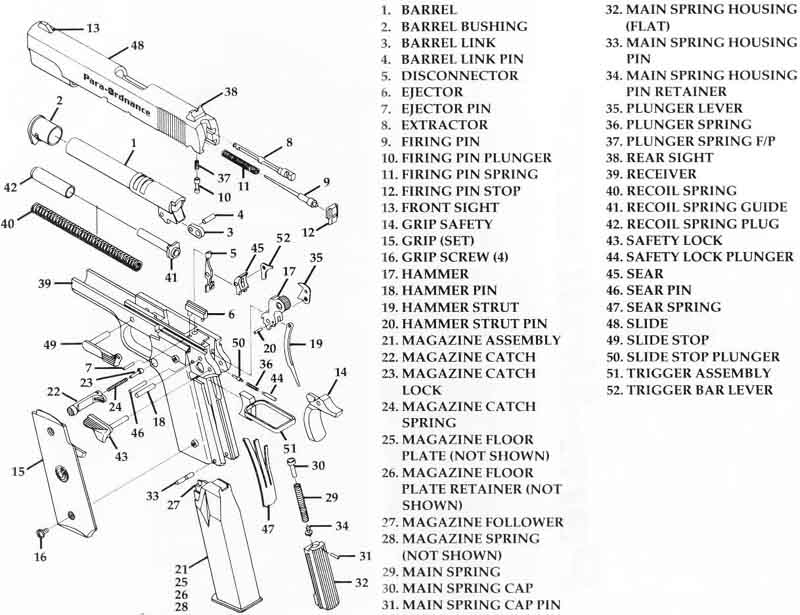
| The Para Ordnance P-12 | The Para Ordnance P-14 | The Mech-Tech (with Para Ord frame) |
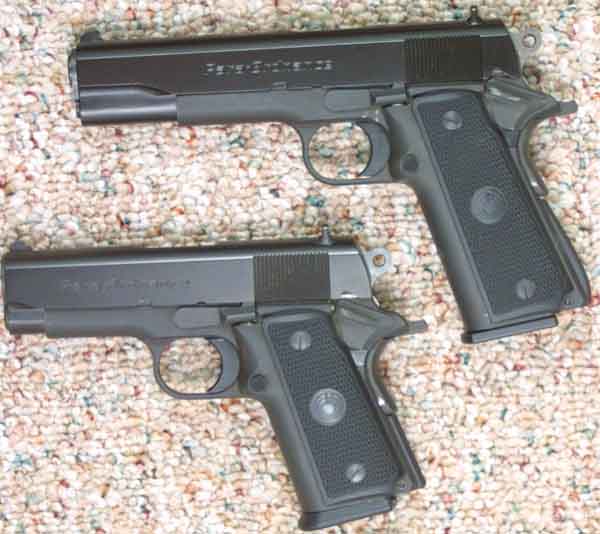 will feel right at home with the Para Ordnance.
will feel right at home with the Para Ordnance. Though the 1911 series, after nearly one hundred years, is beginning to get a bit long in the tooth, it is still one of the most respected, and proven sidearms in the world. The Para Ordnance system has updated the design nicely. This is an example of taking one of the best existing designs, and refining it to the point of near perfection. It is the opposite of the approach taken by the well regarded Glock. The Glock, essentially, threw away the rule book, and took the modern approach of designing a durable, safe, lightweight pistol for the modern fast paced battlefield, and the slightly less weapon savvy soldier (or law enforcement officer) who now populates it. These two approaches have spawned very different types of weapons, though I also consider the Glocks to be among the best of the current crop of pistols.
The Para Ordnance was initially offered as a conversion kit only, consisting of a complete frame, which was to be mated with the owner's existing slide unit. Eventually fully assembled pistols were offered, and then an improved version with a better magazine, and fully supported chamber, as well as improved ergonomics. The initial versions were completely compatible with
 standard M1911 parts (other than the magazines, and a special trigger
with a wide transfer bar). The fully supported chamber of the newer models
makes them somewhat non standard, and a special insert is required for
use with regular M1911 barrels. The photo at right shows this insert,
which sells for around $30. The F in the photo indicats the front of the
insert. At present, the guns are offered in a variety of finishes, different
steels, and an assortment of calibers. They are also available in four sizes,
which roughly correspond to the Government, Commander, Officer's, and a micro
version of the standard M1911. They have become quite popular, and not just
because of their high capacity magazines. The conversion kits are still available,
though the fully assembled guns now constitute the majority of sales.
standard M1911 parts (other than the magazines, and a special trigger
with a wide transfer bar). The fully supported chamber of the newer models
makes them somewhat non standard, and a special insert is required for
use with regular M1911 barrels. The photo at right shows this insert,
which sells for around $30. The F in the photo indicats the front of the
insert. At present, the guns are offered in a variety of finishes, different
steels, and an assortment of calibers. They are also available in four sizes,
which roughly correspond to the Government, Commander, Officer's, and a micro
version of the standard M1911. They have become quite popular, and not just
because of their high capacity magazines. The conversion kits are still available,
though the fully assembled guns now constitute the majority of sales. The company was started, in 1985, by Ted Szabo, and Thanos Polyzos. In common with Calico, Para Ordnance manufactures a line of paint ball guns. These began production before the introduction of the line of double column 45 autos which was to make the company famous. The paint ball guns are fully automatic, but do not use the compressed gas system of most of their competitors. Instead, the guns are fired by pistol primers, which are loaded into cartridges along with the paint balls. The double column frame conversion kits began production in 1988, and were followed by fully assembled pistols in 1990. There was a redesign of the frame units, and then the magazines, in 1992. The new versions were smoother, and more streamlined, and the new magazines had a different style of floor plate, and follower, allowing for one extra round to be carried. The Para Ordnance company is well able to innovate, being capable of plastic, or metal injection molding, as well as CNC machining.
In addition to the double column magazine, the Para Ordinance pistols have a number of other distinctions. The standard frame is made from #357 aluminum alloy, matte finished, and black anodized to a hardness of RC-70. The frame rails are longer than those of a standard 1911, and are unbroken for their full length, giving the frames considerable strength. The guns are a mere 1/8 inch wider than the standard 1911; most shooters are unaware of the difference. The slides are of carbon steel, and already have the ejector port lowered, and relieved, a nice feature for handloaders.
The shooting qualities of these guns are pretty much the shooting qualities of the standard M1911. There are a few distinctions however. With the standard alloy frame, the Para Ordinance guns can be lighter than the regular, steel framed 1911. There is also a distinct difference in the finish of the gun. Rather than the traditional blue, the Para Ordnance has a smooth enamel like finish on the slide, while the alloy frame has a dark finish, and a sandblasted texture. The grips are plastic, shaved very thin to keep the width of the pistol in line with that of the classic Colt. These guns have high profile three dot sights, which are popular in some circles. I like the high profile design, and had formerly (before I learned to shoot properly) liked the three dot system. For those who do not care for the distraction, the dots can be blacked out. The only fault that I can really find with the construction of the gun is the use of plastic for the magazine release, trigger, and sights. Though this is a high quality polymer, I have had bad experiences, in the past, with the use of plastic in the magazine release of my Glock 17, and my older Browning Buck mark.
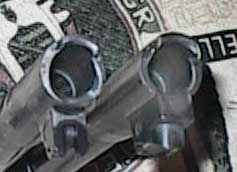 Though the full line of Para Ordnance pistols is now
available in a variety of calibers, I consider the definitive models to
be the offerings in .45 ACP. Other calibers offered are 10mm, 40S&W,
9mm, and 38 Super. The .45 Para Ordnance offers, besides the uncommon double
column magazine, a fully supported chamber, and a feed ramp integral to the
barrel. This takes care of two problems, that have plagued the otherwise
nearly faultless 1911 for decades. When stoked with standard military hardball
ammunition, the old 1911 exhibits no problems, but when attempts are made
to increase power, or go with more lethal bullet designs, difficulties begin
to surface. The most annoying is the failure to feed certain bullet styles
or shapes. this is caused by feed angle, and by the break between the start
of the feed ramp, milled into the frame, and the end of the feed ramp, milled
into the barrel. These must mate perfectly, or stoppages can occur, and
certainly will occur with certain types of bullets. John Browning, the designer
of the M1911, was certainly aware of the problem, and his last design, the
9mm P-35 (high power) featured an integral feed ramp. In the first photograph,
a side by side comparison of barrels, the barrel on the right is of the
new style, with integral feed ramp; the barrel on the left is of the old
style with an unsupported chamber. The second photograph is taken "down
the throat" so to speak, and shows a view of the feed path, through the
open slides of both guns. The standard system is shown at the right, while
the newer, integral ramp system is on the left. It can be readily seen
that the newer system has a much smoother, unbroken path for the cartridge
to traverse.
Though the full line of Para Ordnance pistols is now
available in a variety of calibers, I consider the definitive models to
be the offerings in .45 ACP. Other calibers offered are 10mm, 40S&W,
9mm, and 38 Super. The .45 Para Ordnance offers, besides the uncommon double
column magazine, a fully supported chamber, and a feed ramp integral to the
barrel. This takes care of two problems, that have plagued the otherwise
nearly faultless 1911 for decades. When stoked with standard military hardball
ammunition, the old 1911 exhibits no problems, but when attempts are made
to increase power, or go with more lethal bullet designs, difficulties begin
to surface. The most annoying is the failure to feed certain bullet styles
or shapes. this is caused by feed angle, and by the break between the start
of the feed ramp, milled into the frame, and the end of the feed ramp, milled
into the barrel. These must mate perfectly, or stoppages can occur, and
certainly will occur with certain types of bullets. John Browning, the designer
of the M1911, was certainly aware of the problem, and his last design, the
9mm P-35 (high power) featured an integral feed ramp. In the first photograph,
a side by side comparison of barrels, the barrel on the right is of the
new style, with integral feed ramp; the barrel on the left is of the old
style with an unsupported chamber. The second photograph is taken "down
the throat" so to speak, and shows a view of the feed path, through the
open slides of both guns. The standard system is shown at the right, while
the newer, integral ramp system is on the left. It can be readily seen
that the newer system has a much smoother, unbroken path for the cartridge
to traverse.The fully supported chamber removes the pressure limitation, which many have seen as a handicap of the .45 ACP. I address this at greater length on my 45 auto page, but the problem boils down to a pressure limitation caused by a cut out in the bottom of the chamber. This was needed in order to make the ammunition feed with the two part feed ramp. Unfortunately, this meant that the .45 could not be safely loaded up to velocities much greater than 800-900 fps, with 230 grain bullets. This was not a real problem back at the early part of the last century, but became important latter on, when expanding bullets were developed. In order to work reliably, expanding bullets need to be accelerated up to around 1100 fps. This can not be done safely in a 45 ACP with heavy bullets, and a standard chamber. John M Browning became aware of this weakness, and his future designs, most notably the P-35 (Hi-Power) had a feed ramp integral with the barrel.
The fully supported chamber, along with the full length uninterrupted slide rails, make these guns good candidates for the 45 Super. The .45 super is dimensionally identical to the 45 ACP, but has a stronger case, and is considerably more powerful. With a heavier set of springs, to keep the gun from battering itself to pieces, most fully supported chamber guns, of current manufacture, are up to the task of firing it. These resprung guns are generally still able to fire most types of standard 45 ACP, as well, though low powered ammo designed for target shooting will probably not have enough energy to cycle the action. There is also the so called +P .45 ACP, which is essentially hot loaded standard ammunition, claimed to be safe in any gun in good condition. Presumably these have a stronger case design too, though I would still be wary of firing them in a gun with a standard chamber.
To a certain extent, the high handed laws made by our trusting friends in the democratic party (for our own good, after all), which limits magazine size, somewhat diminishes the advantage of the early pistols. Standard sized Colt magazines can be made to hold 8 rounds, and 9 or 10 round mags are available which extend unobtrusively out the bottom of the magazine well. Fortunately, for Para Ordnance, there is more to the popularity of these guns than just a double column magazine. Fortunately, for Para Ordnance owners, the full capacity magazines are still available, albeit at a cost. An unexpected result of these laws, was the creation of a whole new class of micro sized pistols, designed for civilian carry. The Para Ordnance example is the, very small, P-10, though Glock, S&W, and a number of other companies produce similar models. These are essentially pistols designed around the smallest possible 10 round double column magazine. They have become quite popular. Occasionally, government regulation does produce some benefits.
Para Ordnance has an even more difficult time in it's home nation of Canada. The Canadian government has decided that it's citizens are so untrustworthy, backwards, dishonest, and dangerous, that they may not be allowed to own pistols at all. It can be hoped, that the Canadian citizenry will return the compliment at the next election. As an American, it is really not my place to comment on this. People get the government they want, deserve, or at least, the government they are willing to tolerate. The Canadians have the polling booths, public discourse, and a legal system with which to fight these heavy handed measures. If they chose, there are the means to change these restrictions. My only real comment, is that this should be a cautionary tale for those of us in the United States. Canada has a history somewhat similar to our own, and has a long legacy of exploration, independence, freedom, and a love of the outdoors. Only the Second Amendment has saved us from similar restrictions here, though it becomes less of a protection with every decade.
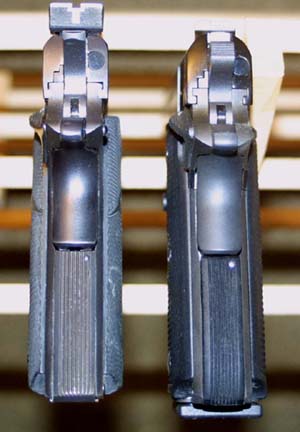
|
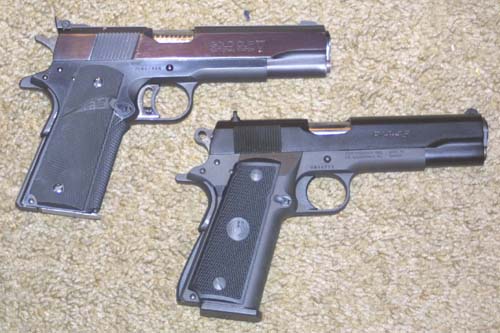
A comparison of the Full sized Para Ordnance (in this case a P-14), and a full sized classic 1911 (in this case, a Gold Cup). Side by side, there is little by which to distinguish them. Even a comparison of the grip size, and shape shows little difference. |
Magazines
 rounds have been available since W.W.I. Initially, these were used by
biplane pilots to shoot at other airplanes. This was in the very early days
of the war, when planes were considered to be tools of reconnaissance rather
than tools of combat. Latter on, a variety of machine guns were adapted for
use in airplanes, some even being timed to fire through the propeller. Today,
the only real practical large magazine is the ten round version. The 25
rounders are very cumbersome, and are often less than completely reliable.
There have even been large, snail shell magazines designed for the 1911,
but they are rare, and are usually priced out of the range of any, but the
most determined collectors. Shown in the photo, are the full sized Para
Ordnance, along with a Gold Cup using an extended magazine. The Gold Cup
is loaded with a ten round magazine, while the Para Ordnance shown, holds
fourteen rounds, in it's standard magazine. Each gun is also able to contain
an extra round in the chamber. Even with the cumbersome extended magazine
hanging out of the butt of the gun, the Gold Cup is still limited to about
two thirds of the capacity of the Para Ordnance. Using standard mags, the
Para Ordnance guns have double the capacity of the standard 1911.
rounds have been available since W.W.I. Initially, these were used by
biplane pilots to shoot at other airplanes. This was in the very early days
of the war, when planes were considered to be tools of reconnaissance rather
than tools of combat. Latter on, a variety of machine guns were adapted for
use in airplanes, some even being timed to fire through the propeller. Today,
the only real practical large magazine is the ten round version. The 25
rounders are very cumbersome, and are often less than completely reliable.
There have even been large, snail shell magazines designed for the 1911,
but they are rare, and are usually priced out of the range of any, but the
most determined collectors. Shown in the photo, are the full sized Para
Ordnance, along with a Gold Cup using an extended magazine. The Gold Cup
is loaded with a ten round magazine, while the Para Ordnance shown, holds
fourteen rounds, in it's standard magazine. Each gun is also able to contain
an extra round in the chamber. Even with the cumbersome extended magazine
hanging out of the butt of the gun, the Gold Cup is still limited to about
two thirds of the capacity of the Para Ordnance. Using standard mags, the
Para Ordnance guns have double the capacity of the standard 1911. The Para Ordnance too, has a selection of magazines. The full sized pistol can take the original thirteen round version, the improved fourteen rounder, or a slightly extended fifteen round mag. There are also the smaller sized twelve, and ten round mags, for the compact pistols.
 Shown in the photograph is a selection of Para Ordnance, and standard
1911 magazines for comparison. On the far right, is the standard seven round,
1911 magazine, shown next to it, is the 10 round, extended magazine. In
the center is the clinton mandated 10 round, modified Para Ordnance magazine,
just to the left of it is the standard, Para Ordnance magazine the way it
was designed, with a capacity of fourteen rounds. On the far left is the
fifteen round magazine.
Shown in the photograph is a selection of Para Ordnance, and standard
1911 magazines for comparison. On the far right, is the standard seven round,
1911 magazine, shown next to it, is the 10 round, extended magazine. In
the center is the clinton mandated 10 round, modified Para Ordnance magazine,
just to the left of it is the standard, Para Ordnance magazine the way it
was designed, with a capacity of fourteen rounds. On the far left is the
fifteen round magazine. Though they look unassuming, the two magazines on the left side of the photo are now restricted to military and police use, except for those produced before September of 1994. In some states (california, new york, new jersey, and possibly some of the other backward areas), the full capacity magazines are banned completely, regardless of the date of manufacture. How this is considered, by the courts, as not being an "infringement" on the Second Amendment, I couldn't say, but then I haven't spent as much time in courtrooms as judges, democratic politicians, and many of the people who vote for them. Those residing in the states which ban these magazines have the same choice as the Canadians: rouse public opinion, vote the supporters of these measure out of office, and challenge the laws in the courts. There is another way to deal with this type of thing; do nothing, and simply live with it. Those who follow the last course, have no business complaining over these restrictions, or against further restrictions to come in the wake of public indifference.
Following the passage of the unconstitutional magazine ban (erroneously titled the crime bill of 1994), Para Ordnance sold all new pistols with a single ten round magazine, but included a coupon for the purchase of a pair of pre ban mags for $50 each. Like many other companies, Para Ordnance saw the ban coming, and proceeded to manufacture, and stockpile magazines for future sales. The magazines had been selling for as much as $200, but seem to have come down into the $75-$125 range, depending upon location. This is little more than the inflation adjusted cost of the magazines, before the ban went into effect.
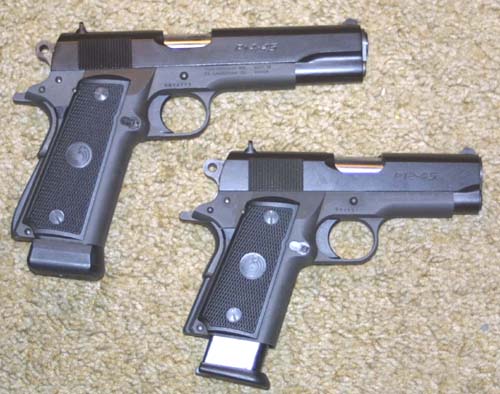 Unfortunately, the price could always go up, particularly if the magazine
ban is extended past it's 2004 expiration date, or made permanent. Only
time, and the vagaries of the political process, will tell.
Unfortunately, the price could always go up, particularly if the magazine
ban is extended past it's 2004 expiration date, or made permanent. Only
time, and the vagaries of the political process, will tell. Though the smaller magazines will only fit in the smaller guns, the full sized, and oversized mags will all fit the smaller guns. Shown in the photograph, is the full sized Para Ordnance (model P-14) with the fifteen round mag, while below it is the compact (model P-12) with the fourteen rounder, which is usually standard on the full sized version. The fifteen round mag appears to be a standard mag with a bumper pad on it, a common enough accessory, particularly for competitive shooters. The smaller gun is obviously not using a standard (for it's size) magazine, but even so, is no more cumbersome, than a standard model would be.
I have been asked by some visitors to my site, what my favorite pistol is. Sometimes the question is posed just this way, other times I am asked what pistol I would carry, or which pistol I would own, if I were only allowed a single gun. My answer to each of these questions is the same: a Para Ordnance P-14. The gun fires my favorite pistol caliber, is accurate, and the handling qualities are those of my familiar 1911. The large magazine, and rust resisting finish, as well as the alloy frame, are intelligent additions to a hundred year old design. Still, nothing is perfect, and there are a few changes I have made, or am about to make. First, I would dump the plastic magazine catch, and the plastic trigger. I will wait to replace them, until they wear out, which will happen eventually (though in fairness to Para Ordnance, I should mention that in almost ten years of ownership, the original plastic fittings are still serviceable). I have already installed heavier springs, so that I can use 45 super rounds in these guns. The springs have enough give, that standard 45 rounds will still cycle the action. For this relatively small investment, the capability of these guns have been greatly increased. I plan to some day replace the sights. In the meantime, I have filled in the three white dots adorning them with sight black. with these additions, I hope to have very nearly the perfect combat, carry, and recreational handgun.
This would seem to be the end of the story, but wait; there is more to the Para Ordnance system, than a fine series of pistols. It is entirely possible, using a Para Ordnance gunsmithing kit, and a Mech-Tech upper unit, to have a Para Ordnance carbine. This is great news, for carbine fans like myself, and also for hunters, survivalists, sportsman, law enforcement officers, or anyone else who can appreciate having a companion piece with a somewhat longer reach than the standard sidearm. Though, being based on a P-14 frame, it will not take the smaller P-12, or P-13 mags, the gun will accept the 14, or 15 round mags designed for the P-14.

This particular example sports an older (pre-1992) frame, which is entirely compatible with all standard 1911 components, greatly easing the assembly of the piece. The newer frames require a block to fit into the area of the frame which is milled out to accept the fully supported chamber area of the new style barrels. This gun extends the range of the 45 ACP quite nicely, and greatly improves shootability, and accuracy. This is a 100 yard gun, though it only offers an energy increase of about 15% over that of the pistol, when firing the 45 ACP. The gun will also comfortably fire the .45 Super, and can wring about 20% to 25% more energy from this round. I hope to do some serious testing with a chronograph this summer, if I can only find the time. I also hope to pick up the tiny P-10 model, and maybe even get a P-13 to round things out. There is talk that Para Ordnance is experimenting with a polymer frame gun, along the lines of the Glock. I do hope that this never comes to pass, since I would have to buy one, and I have far too many guns already. Oh well, it's just a burden I will have to live with.
Some comparative ballistics
| Arm | Cartridge | Barrel | Weight | Velocity | Energy |
| Pistol | 45 ACP | 5" | 230 | 355fp | |
| Carbine | 45 ACP | 18" | 230 | 440fp | |
| Pistol | 45 Super | 5" | 230 | 1200fps | 736fp |
| Carbine | 45 Super | 18" | 230 | ||
| Pistol | 45 Super | 5" | 185 | 1400fps | 805fp |
| Carbine | 45 Super | 18" | 185 |
